1970s French Body Art movement
The 1970s in France saw the Body Art movement flourishing, known as Art Corporel. This movement emerged alongside feminist movements and challenged traditional notions of art and the human body. Here’s a breakdown of critical aspects:
Pioneers and Influences:
- Gina Pane: A leading figure known for using her body as a canvas for performances exploring pain, vulnerability, and endurance. Her work, “The Conditioning,” involved lying on a metal bed frame above lit candles for 30 minutes.
- Other Artists, Michel Journiac, Orlan, Annette Messager, and Vito Acconci (though not French), were also significant contributors, pushing the boundaries of self-expression through bodily actions and interventions.
Influences: The movement drew inspiration from a global art scene, with American artists like Bruce Nauman and the Vienna Actionists playing a significant role. Their use of their bodies in self-destructive performances resonated with the Body Art movement in France.Key Characteristics:
- Focus on the Body: The movement revolutionized art by making the body the central medium, challenging the traditional role of the artist as a creator of objects. This innovative approach sparked a new wave of artistic expression. Ephemerality: Many Body Art performances were not meant to be permanent, existing only at the moment or documented through photographs and videos.
- Exploration of Themes: The movement explored themes of feminism, identity, the objectification of the body, pain, and social commentary.
Contrasting Approaches:
- Enduring Pain: Some artists like Gina Pane pushed their physical limits, using pain to explore vulnerability and challenge societal norms.
- Irony and Challenge: Artists like Vito Acconci used their bodies with a sense of irony, questioning the artist’s role and the audience’s expectations.
Legacy:
Body Art in France challenged traditional art forms and opened doors for more personal and expressive artistic practices. It continues to influence contemporary performance art, encouraging artists to explore the body as a tool for social and political commentary.
Additional Points:
- Body Art in France often differed from the American movement by focusing less on self-promotion and more on social and political critique.
- The movement intersected with feminist struggles, as women artists used their bodies to reclaim agency and challenge objectification.
French Body Art movement Artists
Pioneers of French Body Art: Gina Pane, Michel Journiac, and Orlan
The 1970s in France witnessed a vibrant Art Corporel (Body Art) movement that challenged traditional notions of art and the human body. Here’s a closer look at three key figures who pushed boundaries and redefined artistic expression:
1. Gina Pane (1939-1998)
- Focus: Known for her intense performances that explored pain, vulnerability, and the body’s endurance as a canvas.
- Influences: Inspired by feminist movements, she challenged the objectification of the female form by actively engaging with her body in performances.
- Famous Works:
- “The Conditioning” (1970): Laying naked on a metal bed frame with lit candles underneath for 30 minutes, pushing her physical limits and confronting vulnerability.
- “Action Schmerz” (Action Pain) Series (1971-1974): A series of performances where she inflicted pain on herself with various tools, exploring themes of transgression and self-sacrifice.
2. Michel Journiac (1945 – )
- Focus: Explored themes of ritual and sacrifice through performances often involving repetitive and symbolic actions.
- Style: His work was more metaphorical and symbolic compared to Pane’s direct engagement with pain.
- Famous Works:
- “Action sang” (Blood Action) Series (1970s): Performances incorporating blood and animal organs, often referencing religious rituals and sacrifice.
- “Marches” (Walks) Series (1970s): Ritualistic walks performed in specific locations, blurring the lines between performance and everyday movement.
3. Orlan (1947 – )
- Focus: Pioneered plastic surgery as a performance medium, challenging societal beauty standards and the construction of femininity.
- Style: Her work was more conceptual and theatrical, using her body as a living sculpture to explore identity and social norms.
- Famous Works:
- “The Kiss of the Unicorn” (1977): Performance where she underwent a temporary medical procedure to alter her lips to resemble a unicorn horn.
- “Omnipresence” Series (1989-1993): A series of photographs where she documented her numerous plastic surgeries, questioning the concept of a fixed identity.
Comparisons and Contrasts:
- Pane and Journiac: Both explored themes of sacrifice and the body’s limitations, but Pane’s work was more aggressive, while Journiac’s was more symbolic.
- Orlan: Distanced herself from the focus on pain, favoring a more conceptual approach to using the body as a living art form.
These three artists and others established French Body Art as a powerful movement that challenged traditional art forms, questioned social norms, and explored the human body as a site for artistic expression and social commentary.
The French Body Art movement, Art Corporel, addressed themes like feminism, identity, pain, and social commentary in powerful ways. Here are some specific examples:
Feminism:
- Gina Pane’s “The Conditioning” (1970): By lying naked on a metal bed with lit candles underneath, Pane challenged the objectification of the female body. Her vulnerability and endurance questioned societal expectations of femininity.
- Orlan’s entire body of work: Using plastic surgery as a performance medium, Orlan challenged the idea of a fixed, beautiful female form. Her surgeries questioned societal beauty standards and women’s limited control over their bodies.
Identity:
- Michel Journiac’s “Marches” (Walks) Series (1970s): These repetitive walks blurred the lines between performance and everyday movement, causing viewers to question the constructed nature of identity and social roles.
- Orlan’s “Omnipresence” Series (1989-1993): By documenting her numerous plastic surgeries, Orlan explored the idea of a fluid and ever-changing identity. These surgeries challenged the notion of a fixed self and explored how identity can be constructed and reconstructed.
Pain:
- Gina Pane’s “Action Schmerz” (Action Pain) Series (1971-1974): By inflicting pain on herself, Pane addressed themes of vulnerability, transgression, and the body’s limitations. This self-inflicted pain is a commentary on the pain women endure both physically and metaphorically in society.
- Michel Journiac’s “Action Sang” (Blood Action) Series (1970s): These performances, often incorporating blood and animal organs, explored themes of sacrifice and ritual. The discomfort these performances evoked could be seen as a commentary on social and political violence.
Social Commentary:
- Gina Pane’s entire body of work: Pane’s performances often dealt with social and political oppression themes. Her use of pain and vulnerability could be seen as a critique of societal violence and the repression of emotions.
- Michel Journiac’s use of animal organs in his performances: This could be interpreted as a commentary on the treatment of animals in society and the objectification of living beings.
Table summarizing the key differences:
| Feature | French Art Corporel | American Body Art |
|---|---|---|
| Focus | Social and political critique | Self-exploration |
| Expression | Symbolism and metaphor | Shock value and visceral experiences |
| Pain | Tool for transgression and vulnerability | Catharsis or exploring physical limitations |
French Art Corporel vs. American Body Art: A Tale of Two Movements
The 1970s witnessed a surge in Body Art across the Atlantic, with France and the United States developing vibrant scenes that challenged traditional notions of art and the human body. However, despite exploring similar themes, French Art Corporel and its American counterpart differed in some key aspects:
Focus:
- French Art Corporel: More emphasis on social and political critique. Artists like Gina Pane used their bodies to confront societal violence, oppression, and the objectification of women.
- American Body Art: There is more emphasis on self-exploration and the artist’s body as a canvas. Artists like Bruce Nauman used their bodies in performances that explored themes of self-discovery, isolation, and the limitations of the human form.
Expression:
- French Art Corporel: Greater use of symbolism and metaphor. Michel Journiac’s ritualistic walks and use of animal organs alluded to broader social and political issues.
- American Body Art: More emphasis on shock value and visceral experiences. Chris Burden’s performance “Shoot” (1971), where he had himself shot in the arm, aimed to provoke a strong reaction from the audience.
Pain:
- French Art Corporel: Pain was sometimes used as a tool for transgression and exploring vulnerability. Gina Pane’s self-inflicted pain could be seen as a commentary on societal violence and the repression of emotions.
- American Body Art: Pain could be used for catharsis or exploring physical limitations. Bruce Nauman’s endurance-based performances often pushed the artist to their physical limits.
Similarities:
- Shared themes: Both movements explored themes of identity, the body’s limitations, and the relationship between the artist and the audience.
- Ephemerality: Many Body Art performances were not meant to be permanent, existing only at the moment or documented through photographs and videos.
The challenge to traditional art forms: Both movements, in their ways, grappled with the established art world, bravely redefining the boundaries of art and pushing the limits of societal acceptance.
Though distinct in their approaches, French Art Corporel and American Body Art were both groundbreaking movements that used the body as a powerful tool for artistic expression and social commentary. They continue to influence contemporary performance art, encouraging artists to explore the human body’s potential as a site for artistic creation and social critique.
French Art Corporel
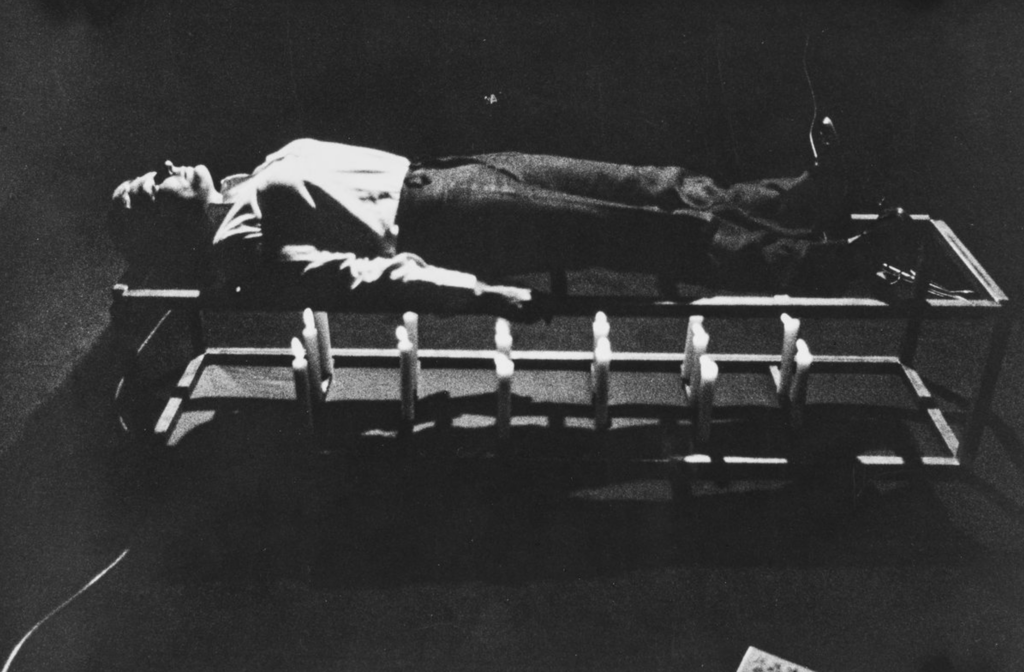
- “The Conditioning” (1970) by Gina Pane:This performance piece is considered a landmark work of French Body Art. Pane lay naked on a metal bed frame with lit candles underneath for 30 minutes, pushing her physical limits and confronting vulnerability.
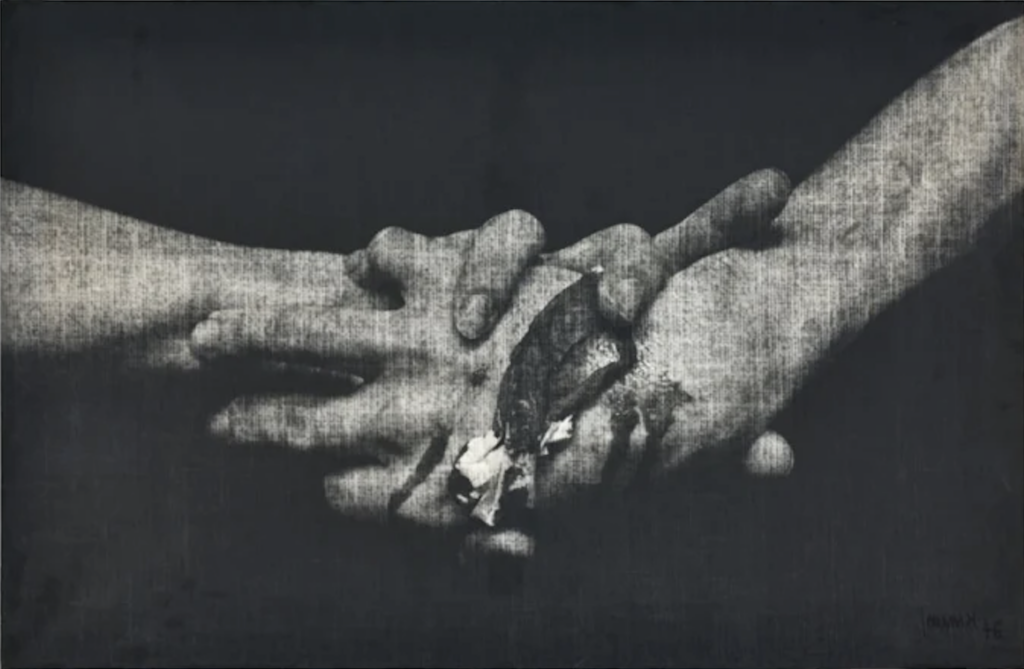
- “Action sang” (Blood Action) Series (1970s) by Michel Journiac:This series of performances explored themes of ritual and sacrifice through the use of blood and animal organs. Journiac’s work was more metaphorical and symbolic compared to Pane’s direct engagement with pain.
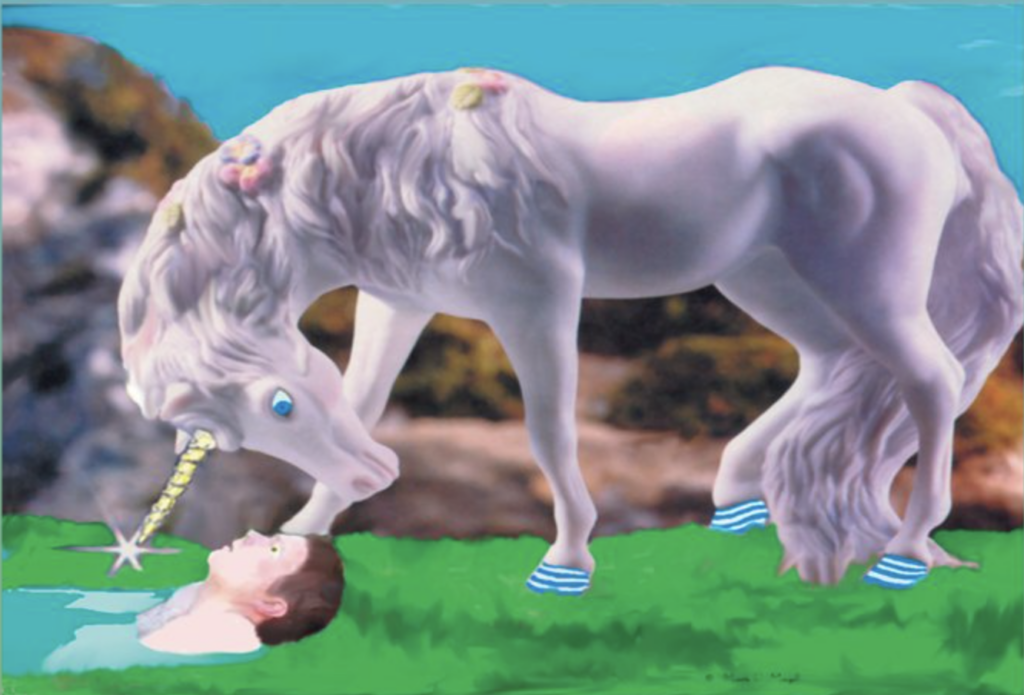
- “The Kiss of the Unicorn” (1977) by Orlan:Orlan, a pioneer of performance art, used plastic surgery as a medium to challenge societal beauty standards and the construction of femininity. In “The Kiss of the Unicorn,” she underwent a temporary medical procedure to alter her lips to resemble a unicorn horn.
- “Omnipresence” Series (1989-1993) by Orlan: A series of photographs where Orlan documented her numerous plastic surgeries, questioning the concept of a fixed identity.
American Body Art
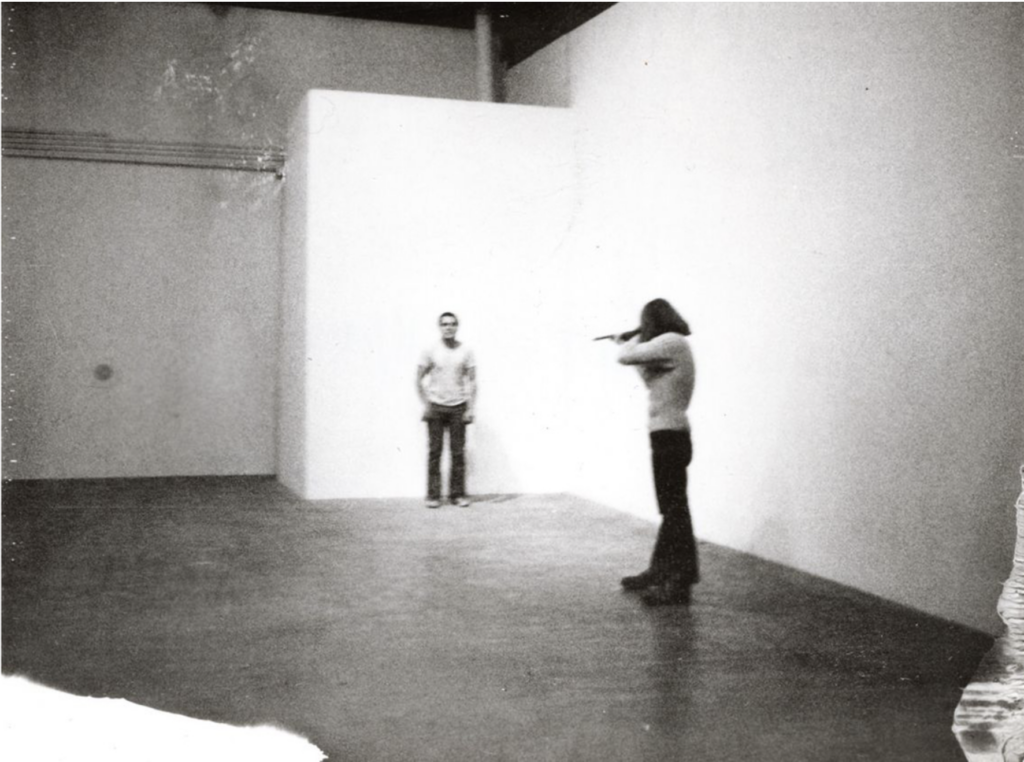
- “Shoot” (1971) by Chris Burden:This controversial performance piece involved Burden having himself shot in the arm with a .22 caliber rifle. The work challenged audiences to confront the boundaries of art and violence.
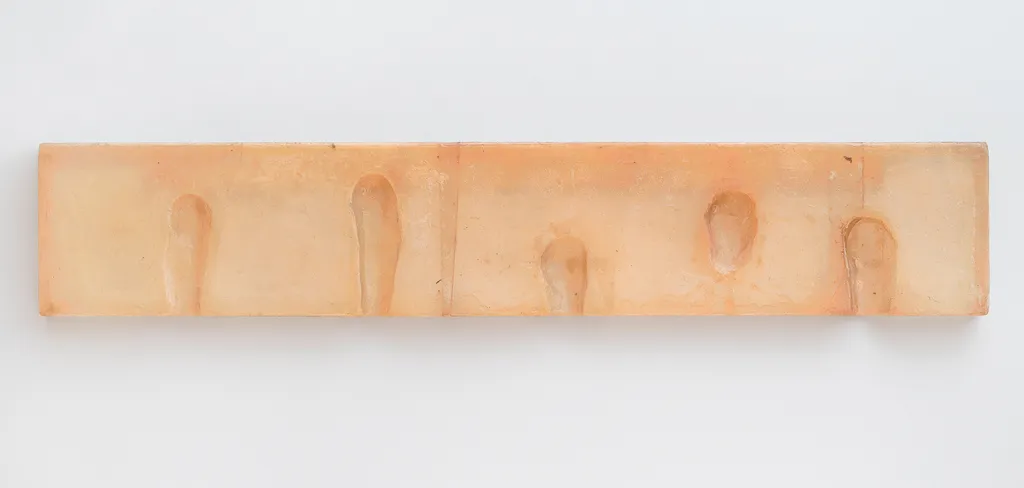
- “Piece of Meat” (1969) by Bruce Nauman:In this performance, Nauman spent several hours walking back and forth in a gallery corridor, taunting and being taunted by viewers. The work explored themes of isolation, vulnerability, and the relationship between artist and audience.
- “Spiral Passage” (1971) by Nancy Grossman:This large-scale environmental sculpture consisted of a wooden ramp leading down into a dark, cramped, and disorienting tunnel. The work explored themes of anxiety, claustrophobia, and the human body’s limitations.
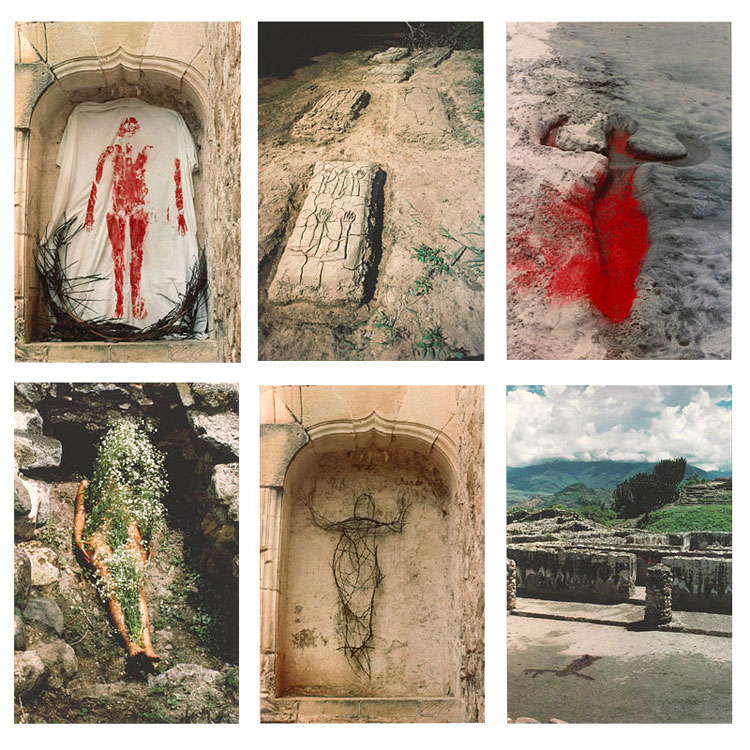
- “Ana Mendieta Series” by Ana Mendieta:Mendieta’s performances often used her body in relationship with nature. She would create body silhouettes using earth and other natural materials, creating a powerful connection between the human form and the environment.




